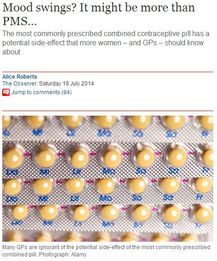"[T]here was something else that Greenhouse said that immediately caught my attention: for some women with more extreme cyclical mood changes, going on the pill could be disastrous."
|
This past weekend, Dr. Alice Roberts published an article on the combined oral contraceptive pill in The Guardian. I was excited to see a media article on contraception by a scientist and a Professor of Public Engagement, assuming it'd be evidence-based and teach me more on writing about science for lay audiences.
The article implies a link between premenstrual dysphoric disorder (PMDD) and oral contraceptive pills, based in part on the opinion of Peter Greenhouse, a consultant in sexual health who sat next to Roberts at a conference dinner. Roberts writes:
A strong assertion! Intrigued, I kept reading, eager for a discussion of the epidemiological evidence behind this statement (which contradicts information in resources like the evidence-based, frequently-updated book, Contraceptive Technology).
5 Comments
When reporting on new scientific research, journalists sometimes seem to sacrifice accurate representation of scientific data for an eyeball-catching headline/story. The scarier the news, the more compelling the headline.
To my understanding, journalists don't always get to write their own headlines, but they do have control over the balance of reporting within the story. When reporting on issues related to contraception, some stories seem to focus exclusively on risks (or present risks out of context), without reporting the benefits of a given contraceptive method. Women deserve to know both the risks and the benefits (and any lingering scientific uncertainties!) related to any contraceptive method they may consider using. |
AuthorA reproductive health epidemiologist who hopes to transmute her rage at social injustice and scientific denialism into something useful. Archives
June 2019
Categories
All
|

 RSS Feed
RSS Feed